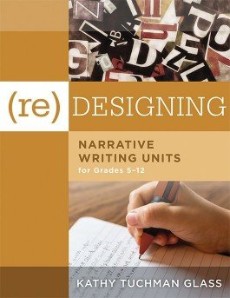Ideas to Strengthen Narrative Writing Units
(re)Designing Narrative Writing Units for Grades 5-12
By Kathy Tuchman Glass
(Solution Tree Press, 2018 – Learn more)

Narrative writing has always been something I dread teaching; it seems kids are either wonderful creative writers or they just don’t get it – there is no in-between. Knowing my teaching had to change, I went in search of some guidance as I planned for another year and I found (re)Designing Narrative Writing Units by Kathy Tuchman Glass.

The introduction is thorough in providing an overview for the book as well as the basics of what narrative writing is and isn’t and who the book was written for.
The first chapters do a good job of explaining the hows and whys of backward curriculum design and how to use this to map a narrative unit (or any unit) to address and assess the standards you aim to teach. Glass includes comprehensive unit map examples to guide you, and then encourages the reader to choose a template and begin planning.
The book is designed to be used as a step-by-step guide for planning a narrative unit and would be extremely helpful to new educators or those looking to revamp units made prior to current standards adoption, but seasoned teachers who are used to this process may find themselves bored by the explanations.
Fresh ideas for teaching narrative writing
By the middle of chapter two, devoted to assessment, I was starting to get some new ideas for teaching narrative, which is what I was hoping for in selecting this title. The author’s ideas for pre-assessment, an area of weakness for me, included a mix of writing samples and use of webs and graphic organizers in a way I hadn’t thought of previously.
Teachers everywhere are using and relying on data from formative assessments increasingly in their planning, and this book provides some solid ideas for quick ways to do this in a manner that will build student skills and not take time away from teaching. I found the section on using rubrics and turning a 4-point rubric into a letter or percentage grade extremely helpful.
Chapters three through five provide the real “meat” of this book. Although I dragged myself through the first 45 pages of (re)Designing, this section pulled me along effortlessly. Chapter three outlines the gradual release model and gives examples using imagery and setting to show readers how it might work.
Chapter four is FULL of activities, strategies, and assessments for all narrative elements (plot, theme, characterization, description etc.) and skills. I can see myself going back to the ideas in this section often for mini lessons on each of the plot elements. The author provides sample excerpts (what others often refer to as ‘mentor texts’) that you can use, and she also includes ideas for adapting a text your class is studying.
Addressing the Common Core
Glass very intentionally addresses the CCSS while providing building blocks for students as they move toward writing their own narratives. I loved that she provided ideas for whole and small group, as well as paired and independent practice with discussion, movement, and hands-out work, as well as the expected quiet writing time.
Lesson activities include grouping and creating rules based on common attributes, voting and rating followed by class discussion, using pictures to create plotlines, practice inventing stories using story cards, sequencing sentence strips, and tracking character actions to make inferences.
I was surprised but excited to see she added lesson ideas for grammatical elements as well, like correctly using dialogue and varying sentence types to help students as they formulate and revise their ideas for clarity (with more on teaching these in the appendix).
Brainstorming graphic organizers and revision checklists are included as Glass guides teachers in helping students make decisions about how to move forward with their writing and self-assessment. To tie this back to our own assessment, she suggests using activity results as non-obtrusive formative assessments. It heartened me to see that Glass shares my view on self-reflection and feedback but not grading everything students write.
While chapter 4 focuses on guiding students toward good writing while focusing on mentor texts, chapter five is all about analyzing and interpreting the texts themselves. The chapter is quite short but has several interactive ideas that would lead to meaningful discussions with and among students. The end product of this unit may be producing a narrative writing piece, but the process will result in students fully understanding all the aspects of a plot and narrative writing and how they work together.
Looking forward
The epilogue has the clearest voice o the entire book, and I wish the author had used that style throughout; she sounds like a teacher just giving advice to a colleague down the hall. Here she outlines next steps and endorses reflection and annotation of your unit map as you teach and after you finish. She encourages the reader to blend what she teaches with other professional learning to do what’s best for your students.
The six-part appendix that follows has a plethora of information and resources from definitions and distinctions between narrative text types to finding appropriate texts and contests as well as links to find complete lessons and units.
While I am not planning to use this book as I think the author intended, I will definitely be returning to chapters four and five to use lesson ideas — and the method to change a rubric score to a grade has already changed my mindset.
I am tired of dreading reading student narratives. This year, with the help of the ideas illustrated in (re)Designing Narrative Writing Units, I have faith that students will know what good narrative writing looks like and produce some quality writing of their own.
Rebecca Crockett currently teaches seventh and ninth grade English and reading in north central Idaho. A twelve-year teaching veteran, she has taught at both the secondary and elementary levels. She is an avid reader and sometimes writer for her own enjoyment and to practice what she preaches. Since 2013 she has been part of the Idaho Coaching Network whose focus is providing professional development and improving teacher practice around the CCSS.


































